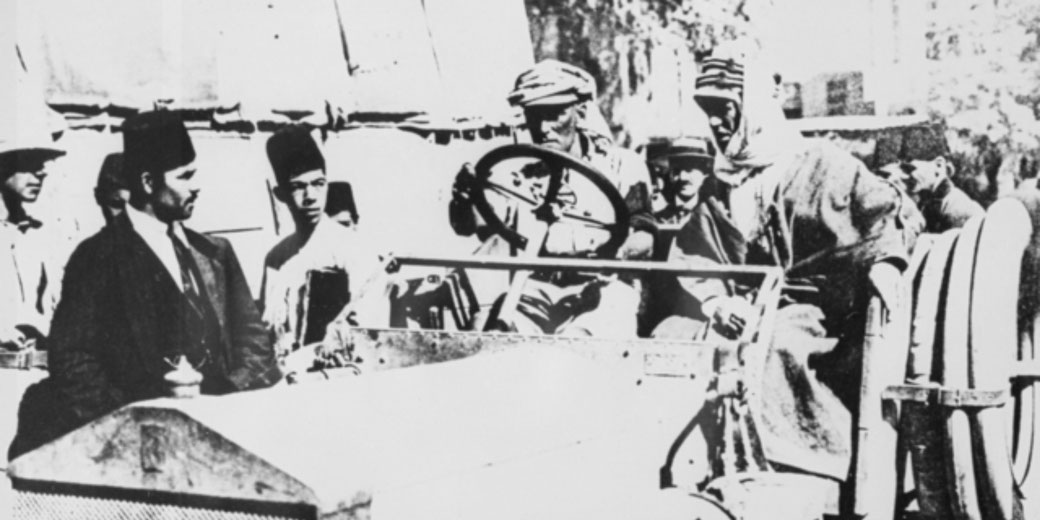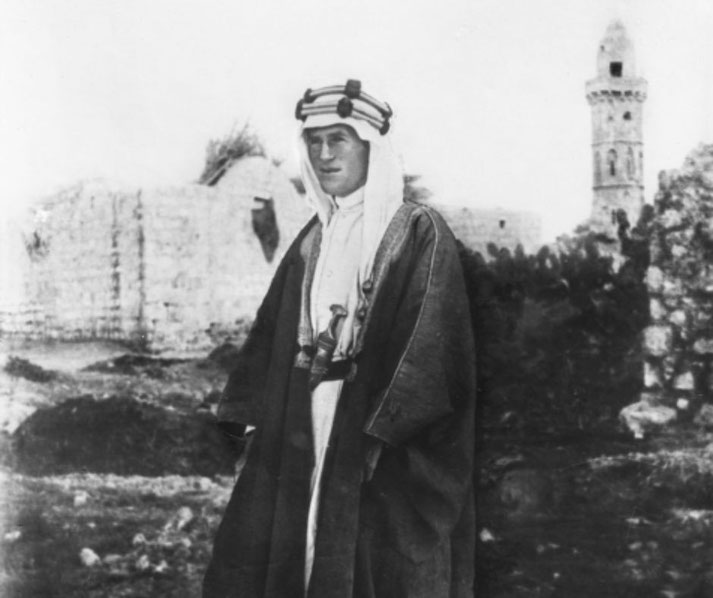Lawrence of Arabia: The amazing story of a British scholar who led an Arab revolt during WWI

T.E. Lawrence, who is more commonly known as Lawrence of Arabia, lived a truly remarkable life. He was a scholar turned warrior, that lives a life filled with daring raids, desert crossings, and alliances with kings and rebels.
However, his role in shaping the Middle East during World War I remains as controversial as it is legendary, even a century after.
But who was the real Lawrence of Arabia?
How did an Oxford-educated archaeologist become a pivotal military strategist in the Arabian desert?
And was he the heroic liberator of Arab nations as often portrayed, or a master of wartime propaganda?
Lawrence's privileged early life
Thomas Edward Lawrence was born on August 16, 1888, in Tremadog, Wales.
The second of five sons, Lawrence grew up in a family that valued education and exploration.
His father, Sir Thomas Chapman, had left his aristocratic life and first family to live with Lawrence's mother, Sarah Junner, a governess.
While he was young, his family moved frequently, eventually settling in Oxford.
Lawrence went to Oxford High School before wining a scholarship to Jesus College, Oxford, in 1907.
Here, his passion for medieval history flourished. For his thesis, Lawrence embarked on a remarkable three-month walking tour of Crusader castles in Ottoman Syria in 1909.
His journey would eventually see him cover over 1,000 miles on foot. The slow pace deepened his appreciation and understanding of the region's history and culture.
During his time at Oxford, Lawrence had developed proficiency in Arabic, which proved invaluable as he interacted with the people he encountered on his travels.
He then returned to England and graduated with First Class Honors in 1910.
After graduation, Lawrence joined an archaeological dig in Carchemish, in what is now Syria.
It was here that he first established significant contacts with people from the Middle East.
How Lawrence began his work for the British army
When World War I broke out in 1914, the Ottoman Empire, which controlled much of the Middle East, allied with the Central Powers against the British.
By chance, Lawrence's expertise in the region and his proficiency in Arabic made him an invaluable asset to British intelligence.
In 1914, he was co-opted by the British military intelligence division in Cairo. He was initially sent to help map the Negev Desert — an area of strategic importance given its proximity to the Suez Canal, which was a crucial link in Britain's empire.
However, Lawrence's role quickly expanded as the war progressed. His knowledge of the local terrain, culture, and language, along with his archaeological experience, proved extremely useful in gathering and analyzing intelligence.
His skills were particularly relevant in the context of the Arab Revolt against the Ottoman Empire.
This is what the British sought to support as part of their war effort.
In 1916, Lawrence was sent to Arabia on an intelligence-gathering mission. There, he met Prince Faisal, a leader of the Arab Revolt.
Lawrence's ability to communicate directly with Faisal and his understanding of Arab grievances and aspirations quickly made him an important liaison between the British and Arab forces.
It didn't take long for him to recognize the potential of the Arab Revolt as a means to weaken the Ottoman Empire.
As a result, Lawrence became deeply involved in advising and supporting the Arab leaders in their struggle for independence.
How he became a leader in the Arab Revolt
Initially, Lawrence's role was primarily as an advisor and intelligence officer.
However, his influence grew rapidly as he developed strong relationships with Arab leaders.
He quickly played a pivotal role in planning and executing guerrilla attacks against the Ottoman forces.
The most famous of these was the capture of Aqaba in July 1917.
This was a cunning and daring assault, as it was launched from an unexpected desert route.
It could become a turning point in the revolt and established Lawrence's reputation as a brilliant military strategist.
Though, Lawrence understood early on that traditional military confrontations against the better-equipped Ottoman forces would likely end in defeat for the Arab fighters.
So, he advocated for a strategy of irregular warfare: focusing on mobility and surprise.
One of Lawrence's key strategies was to target the Hejaz railway. By regularly attacking the railway, he managed to disrupt enemy supplies and communication lines.
This forced the Ottomans to divert significant resources to protect this vital infrastructure.
However, these raids were not designed to cause heavy damage but rather to be a constant source of irritation.
If effective, it would stretch the Ottoman military thin and, hopefully, lower their morale.

Lawrence also placed great emphasis on the element of surprise. He equipped his forces with light weapons and encouraged rapid, hit-and-run tactics.
This approach allowed the Arab forces to strike quickly and then vanish into the desert, confounding the Ottoman army's attempts to engage them in a traditional battle.
Lawrence's strained relationship with the British
One of the key figures in Lawrence's military career was General Edmund Allenby, the British commander in the Middle East.
Allenby and Lawrence shared a mutual respect, with Allenby providing Lawrence with the support and resources needed for the Arab Revolt.
However, there was also an element of mutual wariness in their relationship.
Allenby was focused on the broader objectives of the British military, while Lawrence became deeply invested in the cause of Arab independence.
Unfortunately, Lawrence's interactions with other British officials were not always as positive.
His unconventional methods and close involvement with the Arab leaders sometimes led to skepticism and criticism from some quarters of the British military establishment.
In particular, his attire, adopting Arab clothing, and his immersion in Arab culture, further alienated him from some of his British peers.
Politically, Lawrence's relationship with the British government was even more complicated.
He was involved in the negotiations during and after the war, including the Paris Peace Conference in 1919.
Here, he found himself advocating for Arab independence, often in opposition to the imperial ambitions of the British and French governments.
Ultimately, his advocacy put him at odds with figures like British Foreign Secretary Arthur Balfour and French Premier Georges Clemenceau, who were more interested in dividing the former Ottoman territories between their respective empires.
However, Lawrence's disillusionment with the British government's failure to honor promises of Arab independence gradually deepened over time.
His belief in Arab self-determination was a driving force behind his actions during the revolt.
But the eventual betrayal of these ideals by the Sykes-Picot Agreement and the outcomes of the Paris Peace Conference left him deeply disenchanted.
This disenchantment affected his post-war life and career: leading him to seek a quieter life away from the public eye and the machinations of politics.
Did Lawrence lie to both the British and the Arabs?
Yet, T.E. Lawrence's role in history has been subject to various controversies and criticisms.
One of the primary points of contention is the accuracy and authenticity of his account of the Arab Revolt in his book "Seven Pillars of Wisdom."
Critics have argued on a number of occasions that Lawrence may have exaggerated his role and the effectiveness of the Arab forces to enhance the narrative.
Also, questions have been raised about the veracity of certain events he described.
This has led some to view his memoirs more as a work of literary art than a strict historical record.
Another significant controversy revolves around the Sykes-Picot Agreement.
There is evidence that Lawrence was aware of this secret agreement between Britain and France to divide the Middle East after World War I.
If this is true, it is incredulous that he continued to promise Arab leaders independence.
This duplicity has been seen by some as a betrayal of the Arab cause, although others argue that Lawrence himself was caught in a moral dilemma.
Was he torn between his duties as a British officer and his sympathy for the Arab aspiration for self-rule?
Lawrence's involvement in the Arab Revolt also attracted criticism for its blatantly imperialistic overtones.
Some modern historians argue that his actions were ultimately in service of British imperial interests, rather than genuine support for Arab independence.
As a result, the Arab Revolt was manipulated by the British to weaken the Ottoman Empire.
In this scenario, Lawrence played a key role in this deception.
Additionally, there have been debates over Lawrence's portrayal in popular culture, particularly in the 1962 film "Lawrence of Arabia."
While the film brought his remarkable life to the attention of a broader audience, it has been criticized for romanticizing and simplifying his character and the complex political context of the Arab Revolt.
Consequently, it contributed to a mythologized image of Lawrence: sometimes overshadowing the more problematic aspects of his life and actions.
Sadly, T.E. Lawrence's life came to an abrupt end on May 19, 1935, when he was fatally injured in a motorcycle accident near his home in Dorset, England.
He died six days later on May 19, at the age of 46, as a result of his injuries.
What do you need help with?
Download ready-to-use digital learning resources
Copyright © History Skills 2014-2025.
Contact via email
With the exception of links to external sites, some historical sources and extracts from specific publications, all content on this website is copyrighted by History Skills. This content may not be copied, republished or redistributed without written permission from the website creator. Please use the Contact page to obtain relevant permission.





